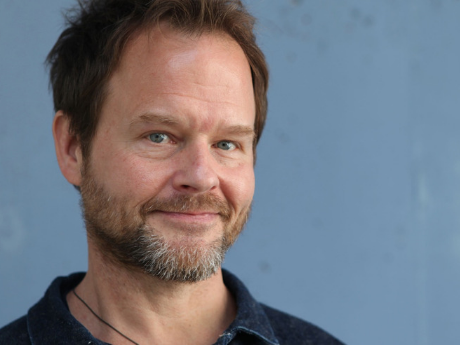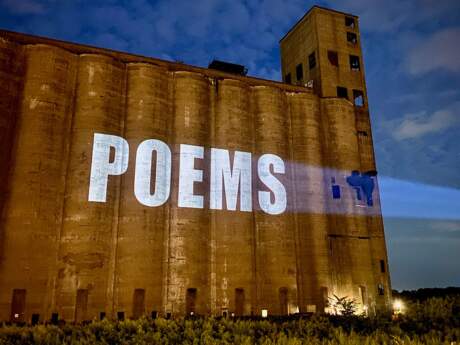Interviews
An Interview with Todd Colby

Fred Sasaki: How are these supposed to work, anyways?
Todd Colby: While working with the postcards I see myself as an architect, a vandal, a sculptor, a landscape artist, and a twister of reality. Whether I am making a monument to a poet or adding a plume of dots over a building, I feel myself entering the landscape as a trickster would and making it new by changing it to the way I'd prefer it to be.
Fred Sasaki: Is it me or is it poetry?
Todd Colby: Actually it's both. The poetry part of the postcards comes in with the use of various captions I sometimes use. I think of the words as captions to film stills, like the captions Chris Marker used in Le Jetee—whenever I watch that beautiful film with subtitles over the stills, I think "postcard!" There's also an element of visual poetic alchemy at work in the postcards. The dotted plumes and roadways offer a stance of transformation, combined with a sincere wish that "I want the world to look like this." Also, if you look at the postcards up close through a magnifying glass, you can see the dot matrix element in the original images. In a way, the dots I've added are a visual commentary on what is seen and not seen. The world is literally a series of dots (atoms) and we're all just bouncing around among them, and sometimes they form amusing shapes.

Fred Sasaki: Are they real poems or did you just make them up yourself?
Todd Colby: The poems are indeed real, even the ones without words.
Fred Sasaki: Who do you intend these to be for?
Todd Colby: I intend for someone to look at these and feel a sense of joy, playfulness and mischief. Similar to the way one would feel watching Andy Kaufman do one of his stand-up routines. Ideally the viewer would suspend their normal sense of looking and enter the landscape of the postcards with wonder.
Fred Sasaki: What is written on the other side? Are there poems behind these poems?
Todd Colby: There are all sorts of messages on the backs of the postcards that people wrote to lovers, friends, and family. I've written the messages down in a separate notebook that I'd love to work with someday. It's really magical reading the messages that are over a century old. In many ways I see myself as a collaborator, not only with the original photographers and colorists of the scenes, but also with the purchaser and message writer of the original postcard. Perhaps in another 100 years or so someone will find my postcards and add additional information to them.
Fred Sasaki: I'd like to talk about your heroes, or the poets who are in these wonderful postcards, even if not by name. I'm wondering if any of them are addressed to those beloved poets or if you've ever actually sent them to people in real life.

Todd Colby: Yes, I've made memorials to many of my favorite poets and writers in the postcards featuring monuments. I repurpose them, and give my heroes their due, so to speak. The writers I've memorialized include: Arthur Rimbaud, Gertrude Stein, Walt Whitman, Djuna Barnes, Charles Baudelaire, Frank O'Hara, Guillaume Apollinaire, Mona Loy, Amiri Baraka, Pierre Reverdy, Max Jacob, James Baldwin, James Schuyler, and many others. I enjoy imagining these large, towering monuments depicted on the postcards which were originally intended for military purposes or some civic chairperson or something. I love turning them into monuments to the greatest writers of our time. They deserve it! Even if they are on 3" x 5" postcards, they take on a scale and gravity that I feel suitably expresses both my reverence for the memorialized writers and my desire to alter and personalize the world depicted in the postcards. I've never sent them to people in real life as actual "postcards." I've sold quite a few of them, so when I mail one to the person who bought it, it's packed in a safe and secure way with an envelope around it.

Fred Sasaki: Do you ever make things worse? Or are these worlds in these postcards always better?
Todd Colby: Sometimes I think I might have made things worse, but the improvements, generally, outweigh the doubts for me. Perhaps my definition of "improvement" is different from other people's. There's a real surge of joy I get from stepping into the landscapes and "defacing" the monuments while showing that I cherish the heritage of so many writers I love and admire who cleared a path for all of us. I'm honoring my heroes, which can be thought of as an improvement. On the other hand, the dot plumes rise out of public pools, cover a mountain road, spew out of the tops of buildings, hang like overly ripe fruit from trees, etc., I can't help but think of myself as a vandal, but the good kind.
Fred Sasaki: When we talk about destruction can we count you out or in?
Todd Colby: It's all about destruction. Not just my art, but all things. Dying is destruction, time is the great destroyer, and all that. With that in mind, yes I'm in, we're all in, we have no choice. But then I see a beautiful sunset, or light bouncing off the back of a bus, and I think maybe light, time passing and our very bodies with their random clusters of atoms are the most beautiful and strange things, even in the midst of chaos and destruction. The mystery!

Fred Sasaki: Also, how dare you? Do you feel you have (or need) permission to appropriate our poets and landscape?
Todd Colby: Ha! Without people daring to do things there would be no meaning to the question "how dare you?" I like to think I'm keeping that question alive in my own small way. Appropriation is a sticky and funny subject. If I had permission to alter a landscape I wouldn't feel as compelled to alter it. Permission undermines mischief. Mischief is a key element in all of my creative endeavors. Not all of them, but an important part. Maybe it's the punk in me, or maybe it's me just wanting to make things "better" in a very subjective way. Right or wrong, it's kind of what we're all doing at the end of the day, right?
Fred Sasaki: How is coloring, drawing and mischief similar to writing poems? Or the reverse?
Todd Colby: All of my creative endeavors are about play and joy and often times sadness. For me they are the very definition of mischief. I mean, if I'm not bringing those things to the table everyday of my life, what's the point?
Fred Sasaki: What do you say to haters?
Todd Colby: I say, "damn it, life is hard." I also say,"I understand."
Fred Sasaki: Tell me about your first mischief experience.
Todd Colby: I was 4 years old in a tiny house in Austin, Minnesota. My mom and dad were getting ready for work, running around the house packing stuff. I spotted an orange on the edge of the counter. Next to it, there was a long knife one would use to slice ham or something. Rather than ask my mom for the orange, I hopped up on a stool in front of the counter, sat up on my knees, and proceeded to slice into the orange with the long sharp knife. It sliced through the orange like the orange was a stick of warm butter and right into my left middle finger. The knife went in deep. Blood was everywhere. I remember I didn't feel anything until my mother entered the room and reacted to the blood all over the place. My parents took me to the hospital and I got a lot of stitches. This was my first memorable mischief.

Fred Sasaki: Sex or Drugs?
Todd Colby: Both are good for the soul in moderation.
Fred Sasaki: Red or Blue?
Todd Colby: Blue.
Fred Sasaki: Sunrise or Sunset?
Todd Colby: Sunrise.
Fred Sasaki: This way or That way?
Todd Colby: I am perpetually at the fork which allows me to go this way or that, at a moment's notice.
Fred Sasaki: Write or Rewrite?
Todd Colby: I've learned to love all the action in rewriting, which is also editing.
Fred Sasaki: Time or Time again?
Todd Colby: Time.
Fred Sasaki: Have or Hold?
Todd Colby: Have.
Fred Sasaki: Life or Death?
Todd Colby: Life.
Fred Sasaki: Time or Space?
Todd Colby: Space.
Fred Sasaki: Yours or Mine?
Todd Colby: Yours.
Fred Sasaki: Heaven or Hell?
Todd Colby: Heaven, for now
Fred Sasaki: I've always felt that postcards require blind faith. They emerge from a place they cannot go back to. They often contain no return address or are cast from somewhere the sender wishes the receiver were also. You might never know if it lands, or who might see what's written on it. There is something inherently sentimental and performative, maybe exhibitionistic, about postcards. I think they're usually sent to special people, yet they're immensely generic, like love. I think of the sticker messages you leave about town, too. How do you reconcile not knowing if your work makes it or not? Or people unwittingly reading or seeing your work and being compelled to respond happily or with annoyance?

Todd Colby: I share the same feeling about blind faith and sending a postcard. There's an odd pleasure in not knowing if the intended receiver received the message. That leap of faith, gambling, is thrilling. Not roller coaster thrilling but something more subtle and melancholy. Over the years I've received postcards in the mail with illegible signatures and wondered who sent it and why? Then I start to look for clues as to its origin. That a postcard would be delivered at all is amazing to me. The idea that it would be delivered to the wrong address, that the wrong person could read it, or that it could simply blow away from out of a mail truck is wonderful to me! The exhibitionism of being a postcard sender, of having written a message for the world to see, is also lovely. The writing is short, and to the point, but it's also injected with condensed meaning, quick jokey words, or phrases that serve as a wink. The writing on the postcards often reads like coded flirtations full of other meanings, or maybe that's just my reading of it. I do feel like a voyeur when I read the text on the postcards, but I also feel a real affection for these people who were thoughtful, literate, well-traveled, and considerate enough to buy, write, and send a postcard to a loved one or acquaintance. There's also a certain amount of pride the senders must have felt, like, "I am traveling, I have seen the hot springs or I have gone to Washington, D.C.," and so on. They are broadcasting the good life we see on Facebook, or Instagram. I feel connected with the compulsion to document and share. It's kind of a perfect definition of what an artist or writer does.
The stickers that I place around NYC are Avery Name Badge Labels #5143 with red border, 2" x 3.5". They provide about the same amount of space to write in as the back of a postcard. I have definitely used them as a vehicle for sending messages to strangers who might see them around the city and be amused or infuriated by them. Either reaction is acceptable, but the joy for me is in never really knowing what people think or who will actually see them. That anonymity is intoxicating for me. I like walking by them on a random Brooklyn street and seeing a weathered one from last summer still hanging onto a light post. There's also the weirder joy of seeing them defaced, painted over, or removed with the remnant of the paper sticker visible. To me, that shows the residue of a reaction. There's that peculiar pleasure that makes me chuckle. The stickers are messages I'd personally like to read on the way to work, or while strolling around town. I present them anonymously. I don't sign them, but they are messages, suggestions, or observations that try to cut through the clutter and establish contact in a different way than advertisements do, for example. Poetry, postcards, and sticker street art all serve a very vital and intertwined purpose for me. I have to mention that even Arthur Rimbaud was a leaver of messages on city walls, particularly when he wrote "merde en dieu" on the side of Saint Sulpice cathedral in Paris. I believe that the impulse to leave messages for others is essentially a very human (and artistic) impulse that I joyfully partake in as often as possible.
Fred Sasaki: What is the message of the messages?
Todd Colby: That's a big can of worms. There's surface, there's texture, there's scale and there's dotted landscapes or words I wrote on some of the postcards. The message is the passage of time and my awareness of it through the alterations, captioning and what not. I'm putting myself into the narrative of the sender and the maker through decades of time and the mere chance that any one of these postcards made their way to me, or me to them. The elongation of the reply period is astonishing to think about. I think about the many postcards I've sent over the years and wonder what will become of them. Will someone do something to them on top of what I've done?
* * *
Todd Colby is the author of six books of poetry, most recently, of Splash State (The Song Cave, 2014) and Flushing Meadows (Scary Topiary Press, 2012). He was the editor of the poetry anthology Heights of the Marvelous: A New York Anthology (St. Martin's Press, 2001) and serves on the board of the Poetry Project. He was the lead singer for the critically acclaimed band Drunken Boat.
Fred Sasaki is the author of Real Life Emails (Tiny Hardcore Press, 2017) and editor, with Don Share, of Who Reads Poetry (University of Chicago Press, 2017). He works as art director for Poetry magazine and a gallery curator for the Poetry Foundation.


